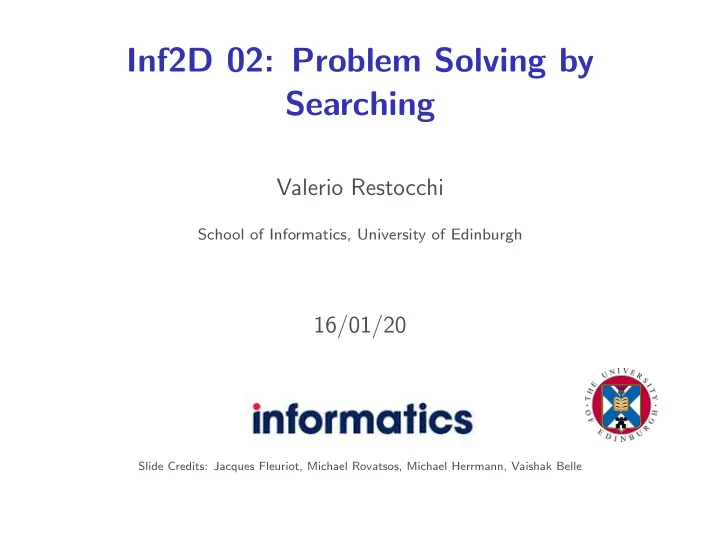

Inf2D 02: Problem Solving by Searching Valerio Restocchi School of Informatics, University of Edinburgh 16/01/20 Slide Credits: Jacques Fleuriot, Michael Rovatsos, Michael Herrmann, Vaishak Belle
Outline − Problem-solving agents − Problem types − Problem formulation − Example problems − Basic search algorithms 2
Problem-solving agents Agent has a “ Formulate, Search, Execute” 3
Example: Romania − On holiday in Romania; currently in Arad. − Flight leaves tomorrow from Bucharest − Formulate goal: ◮ be in Bucharest − Formulate problem: ◮ states: various cities ◮ actions: drive between cities − Find solution: ◮ sequence of cities, e.g., Arad, Sibiu, Fagaras, Bucharest 4
Example: Romania 5
Problem types − Deterministic, fully observable → single-state problem ◮ Agent knows exactly which state it will be in; solution is a sequence − Non-observable → sensorless problem (conformant problem) ◮ Agent may have no idea where it is; solution is a sequence − Nondeterministic and/or partially observable → contingency problem – ◮ percepts provide new information about current state ◮ often interleave search, execution − Unknown state space → exploration problem 6
Example: vacuum world − Single-state, start in #5. Solution? 7
Example: vacuum world − Single-state, start in #5. Solution: [ Right, Suck ] − Sensorless, start in { 1 , 2 , 3 , 4 , 5 , 6 , 7 , 8 } e.g., Right goes to { 2 , 4 , 6 , 8 } Solution? 8
Example: vacuum world − Sensorless, start in { 1 , 2 , 3 , 4 , 5 , 6 , 7 , 8 } e.g., Right goes to { 2 , 4 , 6 , 8 } Solution: [ Right, Suck, Left, Suck ] − Contingency ◮ Nondeterministic: Suck may dirty a clean carpet ◮ Partially observable: location, dirt at current location. ◮ Percept: [ L, Clean ], i.e., start in #5 or #7 Solution? 9
Example: vacuum world − Contingency ◮ Nondeterministic: Suck may dirty a clean carpet ◮ Partially observable: location, dirt at current location. ◮ Percept: [ L, Clean ], i.e., start in #5 or #7 Solution: [ Right, if dirt then Suck ] 10
Single-state problem formulation A problem is defined by four items: − initial state e.g., “in Arad” − actions or successor function S ( x ) =set of action–state pairs ◮ e.g., S (Arad) = {� Arad → Zerind , Zerind � , . . . } − goal test, can be ◮ explicit, e.g., x = “in Bucharest” ◮ implicit, e.g., Checkmate ( x ) − path cost (additive) ◮ e.g., sum of distances, number of actions executed, etc. ◮ c ( x , a , y ) is the step cost of taking action a in state x to reach state y, assumed to be ≥ 0 − A solution is a sequence of actions leading from the initial state to a goal state 11
Selecting a state space − Real world is absurdly complex → state space must be abstracted for problem solving − (Abstract) state = set of real states − (Abstract) action = complex combination of real actions ◮ e.g., “Arad → Zerind” represents a complex set of possible routes, detours, rest stops, etc. − For guaranteed realizability, any real state “in Arad” must get to some real state “in Zerind” − (Abstract) solution = ◮ set of real paths that are solutions in the real world − Each abstract action should be “easier” than the original problem 12
Vacuum world state space graph − states? − actions? − goal test? − path cost? 13
Vacuum world state space graph − states? Pair of dirt and robot locations − actions? Left, Right, Suck − goal test? no dirt at any location − path cost? 1 per action 14
Example: The 8-puzzle − states? − actions? − goal test? − path cost? 15
Example: The 8-puzzle − states? locations of tiles − actions? move blank left, right, up, down − goal test? = goal state (given) − path cost? 1 per move 16
Example: robotic assembly − states?: real-valued coordinates of robot joint angles & parts of the object to be assembled − actions?: continuous motions of robot joints − goal test?: complete assembly − path cost?: time to execute 17
Tree search algorithms − Basic idea: ◮ offline, simulated exploration of state space by generating successors of already-explored states (a.k.a. expanding states) 18
Tree search example 19
Tree search example 20
Tree search example 21
Implementation: general tree search 22
Implementation: states vs. nodes − A state is a (representation of) a physical configuration − A node is a book-keeping data structure constituting part of a search tree includes state, parent node, action, path cost − Using these it is easy to compute the components for a child node. (The CHILD-NODE function) 23
Summary − Problem formulation usually requires abstracting away real-world details to define a state space that can feasibly be explored. 24
Recommend
More recommend